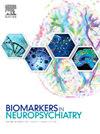青春期边缘型人格障碍患者神经生物学方面的系统综述
Q2 Medicine
引用次数: 0
摘要
边缘型人格障碍是一种复杂的心理健康状况,在情绪、自我感知和人际关系方面存在障碍。它在青春期出现,在成年早期达到顶峰,影响1 %-3 %的个体。方法我们将这篇综述发表在PROSPERO杂志上,注册码为CRD4202126220。随后,我们在Pubmed, PsycINFO, Medline, Embase, Web of Science和Scopus数据库中进行了全面的搜索。一个系统的综合集中在边缘型人格障碍的神经生物学基础提出。结果共纳入22项研究,受试者1400人。10/22和4/22的研究主要来自澳大利亚和德国。遗传研究发现,5-HTTLPR短等位基因与边缘型人格障碍特征升高有关,并揭示了神经内分泌的改变。而成像研究记录了脑结构的变化,如背外侧额回和海马体,以及前扣带皮层和胼胝体的体积减少。电生理研究表明,在边缘型人格障碍青少年中,特别是在情绪测试中,P300振幅下降和α相同步增加的异常脑成熟。结论:虽然边缘型人格障碍症状可能从青春期持续到成年,但现有证据在神经生物学研究结果中缺乏一致性。前额皮质、眶额皮质、杏仁核和海马的差异显示出潜在的显著性,但电生理、生化和遗传学方面的差异缺乏可推广的证据。需要进行纵向研究和进一步调查。本文章由计算机程序翻译,如有差异,请以英文原文为准。
A systematic review of neurobiological aspects of borderline personality disorder among adolescent patients
Background
Borderline personality Disorder is a complex mental health condition with disturbances in emotions, self-perception, and relationships. Emerging in adolescence, it reaches its peak in early adulthood, impacting 1 %-3 % of individuals.
Methods
We documented this review in PROSPERO with the registration code CRD4202126220. Subsequently, we conducted a comprehensive search across Pubmed, PsycINFO, Medline, Embase, Web of Science and Scopus databases. A systematic synthesis focusing on the neurobiological foundations of borderline personality disorder is presented.
Results
A total of 22 studies and 1400 participants were included. Most of the studies 10/22 and 4/22 were from Australia and Germany, respectively. Genetic findings linked the short allele of 5-HTTLPR to the elevated borderline personality disorder traits and revealed neuroendocrine alterations. While imaging studies documented structural brain changes in areas such as the dorsolateral frontal gyrus and hippocampus, and reduced volumes in the anterior cingulate cortex and corpus callosum. Electrophysiological studies indicated abnormal cerebral maturation with diminished P300 amplitudes and increased alpha phase synchrony in borderline personality disorder adolescents, particularly during emotional tests.
Conclusion
We concluded that while borderline personality disorder symptoms may endure from adolescence into adulthood, existing evidence lacks consistency in neurobiological findings. Differences in the prefrontal cortex, orbitofrontal cortex, amygdala and hippocampus showed potential significance, however, electrophysiological, biochemical and genetic presented insufficient generalizable evidence for adolescents. Longitudinal studies and further investigation are needed.
求助全文
通过发布文献求助,成功后即可免费获取论文全文。
去求助
来源期刊

Biomarkers in Neuropsychiatry
Medicine-Psychiatry and Mental Health
CiteScore
4.00
自引率
0.00%
发文量
12
审稿时长
7 weeks
 求助内容:
求助内容: 应助结果提醒方式:
应助结果提醒方式:


